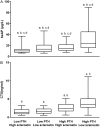Circulating levels of sclerostin but not DKK1 associate with laboratory parameters of CKD-MBD
- PMID: 28493902
- PMCID: PMC5426702
- DOI: 10.1371/journal.pone.0176411
Circulating levels of sclerostin but not DKK1 associate with laboratory parameters of CKD-MBD
Abstract
Introduction: Mounting evidence indicates that a disturbed Wnt-β-catenin signaling may be involved in the pathogenesis of chronic kidney disease-mineral and bone and mineral disorder (CKD-MBD). Data on the impact of CKD on circulating levels of the Wnt antagonists sclerostin and Dickkopf related protein 1 (DKK1) and the relationship with laboratory parameters of CKD-MBD are incomplete.
Methods: We analyzed serum sclerostin and DKK1 in 308 patients across the stages of chronic kidney disease (kDOQI stage 1-2 n = 41; CKD stage 3 n = 54; CKD stage 4-5 n = 54; hemodialysis n = 100; peritoneal dialysis n = 59) as well as in 49 healthy controls. We investigated associations with demographics, renal function, parameters of mineral metabolism including 25(OH) vitamin D, 1,25(OH)2 vitamin D, biointact fibroblast growth factor 23 (FGF23), and parathyroid hormone (PTH), and bone turnover markers.
Results: Serum sclerostin, but not DKK1, increases in more advanced stages of CKD and associates with PTH, phosphate, and 1,25(OH)2 vitamin D concentrations. Bone turnover markers are highest in hemodialysis patients presenting the combination of high PTH with low sclerostin level. Serum DKK1 levels are lower in CKD patients than in controls and are not associated with laboratory parameters of mineral metabolism. Interestingly, a direct association between DKK1 and platelet count was observed.
Conclusion: In CKD, serum levels of the Wnt inhibitors DKK1 and sclerostin are unrelated, indicating different sites of origin and/ or different regulatory mechanisms. Sclerostin, as opposed to DKK1, may qualify as a biomarker of CKD-MBD, particularly in dialysis patients. DKK1 serum levels, remarkably, correlate almost uniquely with blood platelet counts.
Conflict of interest statement
Figures



Comment in
-
Serum dickkopf-related protein 1 and sclerostin may predict the progression of chronic kidney disease in Japanese patients.Nephrol Dial Transplant. 2019 Aug 1;34(8):1426-1427. doi: 10.1093/ndt/gfz078. Nephrol Dial Transplant. 2019. PMID: 31056712 No abstract available.
Similar articles
-
Circulating Levels of Dickkopf-Related Protein 1 Decrease as Measured GFR Declines and Are Associated with PTH Levels.Am J Nephrol. 2020;51(11):871-880. doi: 10.1159/000511658. Epub 2020 Nov 25. Am J Nephrol. 2020. PMID: 33238271
-
Circulating sclerostin and Dickkopf-1 (DKK1) in predialysis chronic kidney disease (CKD): relationship with bone density and arterial stiffness.Calcif Tissue Int. 2012 Jun;90(6):473-80. doi: 10.1007/s00223-012-9595-4. Epub 2012 Apr 21. Calcif Tissue Int. 2012. PMID: 22527202
-
Relationship between plasma levels of sclerostin, calcium-phosphate disturbances, established markers of bone turnover, and inflammation in haemodialysis patients.Int Urol Nephrol. 2019 Mar;51(3):519-526. doi: 10.1007/s11255-018-2050-3. Epub 2018 Dec 24. Int Urol Nephrol. 2019. PMID: 30584645 Free PMC article.
-
Sclerostin and DKK1: new players in renal bone and vascular disease.Kidney Int. 2015 Aug;88(2):235-40. doi: 10.1038/ki.2015.156. Epub 2015 Jun 17. Kidney Int. 2015. PMID: 26083653 Review.
-
Fractures in patients with CKD-diagnosis, treatment, and prevention: a review by members of the European Calcified Tissue Society and the European Renal Association of Nephrology Dialysis and Transplantation.Kidney Int. 2017 Dec;92(6):1343-1355. doi: 10.1016/j.kint.2017.07.021. Epub 2017 Sep 28. Kidney Int. 2017. PMID: 28964571 Review.
Cited by
-
Updates in the chronic kidney disease-mineral bone disorder show the role of osteocytic proteins, a potential mechanism of the bone-Vascular paradox, a therapeutic target, and a biomarker.Front Physiol. 2023 Jan 26;14:1120308. doi: 10.3389/fphys.2023.1120308. eCollection 2023. Front Physiol. 2023. PMID: 36776982 Free PMC article. Review.
-
Klotho/FGF23 and Wnt Signaling as Important Players in the Comorbidities Associated with Chronic Kidney Disease.Toxins (Basel). 2020 Mar 16;12(3):185. doi: 10.3390/toxins12030185. Toxins (Basel). 2020. PMID: 32188018 Free PMC article. Review.
-
El diálogo oculto entre el hueso y los tejidos a través del remodelado óseo.Adv Lab Med. 2023 Sep 22;5(1):35-45. doi: 10.1515/almed-2023-0101. eCollection 2024 Mar. Adv Lab Med. 2023. PMID: 38634083 Free PMC article. Spanish.
-
Mendelian Randomization Analysis Reveals a Causal Influence of Circulating Sclerostin Levels on Bone Mineral Density and Fractures.J Bone Miner Res. 2019 Oct;34(10):1824-1836. doi: 10.1002/jbmr.3803. Epub 2019 Aug 2. J Bone Miner Res. 2019. PMID: 31170332 Free PMC article.
-
Serum bone markers in ROD patients across the spectrum of decreases in GFR: Activin A increases before all other markers .Clin Nephrol. 2019 Apr;91(4):222-230. doi: 10.5414/CN109650. Clin Nephrol. 2019. PMID: 30862350 Free PMC article.
References
MeSH terms
Substances
LinkOut - more resources
Full Text Sources
Other Literature Sources
Research Materials

